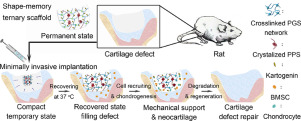当前位置:
X-MOL 学术
›
Acta Biomater.
›
论文详情
Our official English website, www.x-mol.net, welcomes your feedback! (Note: you will need to create a separate account there.)
Biofunctionalized chondrogenic shape-memory ternary scaffolds for efficient cell-free cartilage regeneration.
Acta Biomaterialia ( IF 9.7 ) Pub Date : 2020-01-15 , DOI: 10.1016/j.actbio.2020.01.015 Huixia Xuan 1 , Haoran Hu 2 , Congying Geng 1 , Jianchun Song 1 , Yifan Shen 2 , Dong Lei 1 , Qingbao Guan 1 , Shichang Zhao 2 , Zhengwei You 1
Acta Biomaterialia ( IF 9.7 ) Pub Date : 2020-01-15 , DOI: 10.1016/j.actbio.2020.01.015 Huixia Xuan 1 , Haoran Hu 2 , Congying Geng 1 , Jianchun Song 1 , Yifan Shen 2 , Dong Lei 1 , Qingbao Guan 1 , Shichang Zhao 2 , Zhengwei You 1
Affiliation

|
Cartilage defect repair remains a great clinical challenge due to the limited self-regeneration capacity of cartilage tissue. Surgical treatment of injured cartilage is rather difficult due to the narrow space in the articular cavity and irregular defect area. Herein, we designed and fabricated chondrogenic and physiological-temperature-triggered shape-memory ternary scaffolds for cell-free cartilage repair, where the poly (glycerol sebacate) (PGS) networks ensured elasticity and shape recovery, crystallized poly (1,3-propylene sebacate) (PPS) acted as switchable phase, and immobilized bioactive kartogenin (KGN) endowed the scaffolds with chondrogenic capacity. The resultant scaffolds exhibited shape-memory properties with shape-memory fixed ratio of 98% and recovered ratio of 97% at 37°C for PPS/PGS/KGN-100, indicating a good potential for minimally invasive implantation. The scaffolds gradually degraded in Dulbecco's phosphate-buffered saline and released KGN up to 12 weeks in vitro. In addition, the scaffolds promoted chondrogenic differentiation while inhibiting osteogenic differentiation of bone marrow-derived mesenchymal stem cells in a concentration-dependent manner and cartilage regeneration in full-thickness defects of rat femoropatellar groove for 12 weeks. Consequently, the PPS/PGS/KGN-100 scaffolds stimulated the formation of an overlying layer of neocartilage mimicking the characteristic architecture of native articular cartilage even in the absence of exogenous growth factors and seeded cells. This study provides much inspiration for future research on cartilage tissue engineering. STATEMENT OF SIGNIFICANCE: There are two crucial challenges for cartilage defect repair: the lack of self-regeneration capacity of cartilage tissue and difficult scaffold implantation via traditional open surgery due to space-limited joints. Herein, bioactive body-temperature-responsive shape memory scaffolds are designed to simultaneously address the challenges. The scaffolds can be readily implanted by minimally invasive approach and recover by body-temperature of patient. The integration of kartogenin endows scaffolds the bioactivity, leading to the first example of bulk shape-memory scaffolds for cell-free cartilage repair. These characteristics make the scaffolds advantageous for clinical translation. Moreover, our developed material is easy to be functionalized due to the presence of extensive free hydroxyl groups and provides a versatile platform to design diverse functional shape memory biomaterials.
中文翻译:

生物功能化软骨形成形状记忆三元支架,可有效实现无细胞软骨再生。
由于软骨组织的自我再生能力有限,软骨缺陷修复仍然是一个巨大的临床挑战。由于关节腔内狭窄的空间和不规则的缺损区域,对软骨受伤的手术治疗相当困难。在这里,我们设计和制造了软骨和生理温度触发的形状记忆三元支架,用于无细胞软骨修复,其中聚癸二酸甘油酯(PGS)网络确保弹性和形状恢复,结晶聚(1,3-丙烯癸二酸酯(PPS)作为可转换相,固定化的生物活性卡托菌素(KGN)使支架具有软骨形成能力。对于PPS / PGS / KGN-100,所得支架在37°C下具有98%的形状记忆固定率和97%的回收率。表明微创植入的良好潜力。支架在Dulbecco的磷酸盐缓冲盐水中逐渐降解,并在体外长达12周释放KGN。此外,该支架促进软骨形成分化,同时以浓度依赖性方式抑制骨髓间充质干细胞的成骨分化,并在大鼠股骨沟全层缺损中软骨再生达12周。因此,即使在没有外源生长因子和种子细胞的情况下,PPS / PGS / KGN-100支架也刺激了新软骨的覆盖层的形成,模仿了天然关节软骨的特征结构。这项研究为软骨组织工程的未来研究提供了很多启示。重要性声明:软骨缺损修复面临两个关键挑战:软骨组织缺乏自我再生能力,由于关节空间有限,传统的开放式手术难以植入支架。本文中,生物活性的体温响应形状记忆支架被设计为同时应对挑战。支架可通过微创方法轻松植入,并通过患者体温恢复。卡尔托金菌素的整合赋予了支架生物活性,这导致了用于无细胞软骨修复的体形记忆支架的第一个实例。这些特征使支架有利于临床翻译。此外,
更新日期:2020-01-15
中文翻译:

生物功能化软骨形成形状记忆三元支架,可有效实现无细胞软骨再生。
由于软骨组织的自我再生能力有限,软骨缺陷修复仍然是一个巨大的临床挑战。由于关节腔内狭窄的空间和不规则的缺损区域,对软骨受伤的手术治疗相当困难。在这里,我们设计和制造了软骨和生理温度触发的形状记忆三元支架,用于无细胞软骨修复,其中聚癸二酸甘油酯(PGS)网络确保弹性和形状恢复,结晶聚(1,3-丙烯癸二酸酯(PPS)作为可转换相,固定化的生物活性卡托菌素(KGN)使支架具有软骨形成能力。对于PPS / PGS / KGN-100,所得支架在37°C下具有98%的形状记忆固定率和97%的回收率。表明微创植入的良好潜力。支架在Dulbecco的磷酸盐缓冲盐水中逐渐降解,并在体外长达12周释放KGN。此外,该支架促进软骨形成分化,同时以浓度依赖性方式抑制骨髓间充质干细胞的成骨分化,并在大鼠股骨沟全层缺损中软骨再生达12周。因此,即使在没有外源生长因子和种子细胞的情况下,PPS / PGS / KGN-100支架也刺激了新软骨的覆盖层的形成,模仿了天然关节软骨的特征结构。这项研究为软骨组织工程的未来研究提供了很多启示。重要性声明:软骨缺损修复面临两个关键挑战:软骨组织缺乏自我再生能力,由于关节空间有限,传统的开放式手术难以植入支架。本文中,生物活性的体温响应形状记忆支架被设计为同时应对挑战。支架可通过微创方法轻松植入,并通过患者体温恢复。卡尔托金菌素的整合赋予了支架生物活性,这导致了用于无细胞软骨修复的体形记忆支架的第一个实例。这些特征使支架有利于临床翻译。此外,


























 京公网安备 11010802027423号
京公网安备 11010802027423号